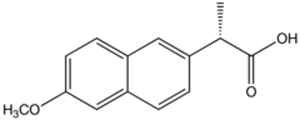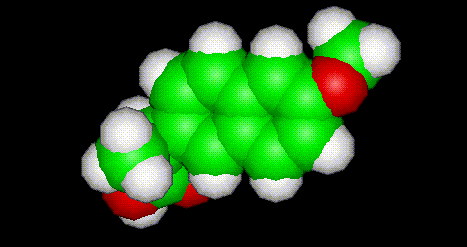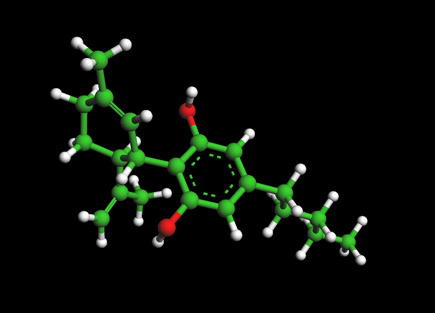Naproxen Molecule Ball-and-Stick Model
To View the Naproxen Molecule --->>in 3D with Jsmol
Naproxen is a non-steroidal anti-inflammatory drug (NSAID) -- see also: (see also: ibuprofen, tylenol, aspirin, vioxx, celebrex, and bextra.) -- commonly used for the reduction of moderate to severe pain, fever, inflammation and stiffness caused by conditions such as osteoarthritis, rheumatoid arthritis, psoriatic arthritis, gout, ankylosing spondylitis, injury (like fractures), menstrual cramps, tendinitis, bursitis, and the treatment of primary dysmenorrhea. Naproxen and naproxen sodium are marketed under various trade names including: Aleve, Anaprox, Miranax, Naprogesic, Naprosyn, Naprelan, Synflex.

Naproxen Molecular Struture
Naproxen was first and originally marketed as the prescription drug Naprosyn in 1976 and naproxen sodium was first marketed under the trade name Anaprox in 1980. It remains a prescription-only drug in much of the world. The U.S. Food and Drug Administration (FDA) approved the use of naproxen sodium as an over-the-counter (OTC) drug in 1994, where OTC preparations are sold under the trade name Aleve. In Australia, small packets of lower-strength preparations of na Structure and details.
Naproxen is a member of the 2-arylpropionic acid (profen) family of NSAIDs. It is an odorless, white to off-white crystalline substance. It is lipid-soluble and practically insoluble in water. It has a melting point of 153°C.
Adverse effects and warnings
Like other NSAIDs, naproxen is capable of producing disturbances in the gastrointestinal tract. Addition of a proton pump inhibitor such as esomeprazole will prevent this adverse effect.
Also like other NSAIDs, naproxen can inhibit the excretion of sodium and lithium. Extreme care must be taken by those who use this drug along with lithium supplements. Naproxen is also not recommended for use with NSAIDs of the salicylate family (drugs may reduce each other's effects), nor with anticoagulants (may increase risk of bleeding). Naproxen preparations containing sodium (e.g., Anaprox, Aleve, etc.) are not recommended for use in patients with sodium-sensitive hypertension, due to potential adverse effects on blood pressure in this small subset of hypertensive patients.
In August 2006, the journal Birth Defects Research Part B published results in the September issue indicating that pregnant women who take NSAIDs including naproxen in the first trimester run an increased risk of having a child with congenital birth defects, particularly heart anomalies.
Risk of heart attack or stroke
The National Institutes of Health prematurely terminated a randomized clinical trial of naproxen and celecoxib for prevention of Alzheimer's disease, after preliminary data suggested an increased risk of major cardiovascular events, such as heart attack or stroke, in patients taking naproxen. However, recent meta-analyses which took into account all data from significant clinical trials of naproxen, including randomized clinical trials and observational trials concluded that naproxen carries no increased risk of heart attack or stroke at any commonly used dose. This stands in contrast to other NSAIDS, such as rofecoxib (Vioxx), celecoxib (Celebrex), and diclofenac, which did show significantly increased risk at some or all dosages. In February of 2007, the American Heart Association released a scientific statement advising that, when possible, physicians should avoid using NSAIDs in patients at high risk for heart disease. When pain relief is necessary, the AHA advises that doctors should preferentially use acetaminophen or certain older, non-COX-2 selective NSAIDs.
Naproxen was first and originally marketed as the prescription drug Naprosyn in 1976 and naproxen sodium was first marketed under the trade name Anaprox in 1980. It remains a prescription-only drug in much of the world. The U.S. Food and Drug Administration (FDA) approved the use of naproxen sodium as an over-the-counter (OTC) drug in 1994, where OTC preparations are sold under the trade name Aleve. In Australia, small packets of lower-strength preparations of napStructure and details
Naproxen is a member of the 2-arylpropionic acid (profen) family of NSAIDs. It is an odorless, white to off-white crystalline substance. It is lipid-soluble and practically insoluble in water. It has a melting point of 153 °C.
External links
- CID 1302 from PubChem
- EINECS number 244-838-7
- MedlinePlus Information on naproxen
- FDA Statement on Naproxen
- Alzheimer's Disease Anti-Inflammatory Prevention Trial

